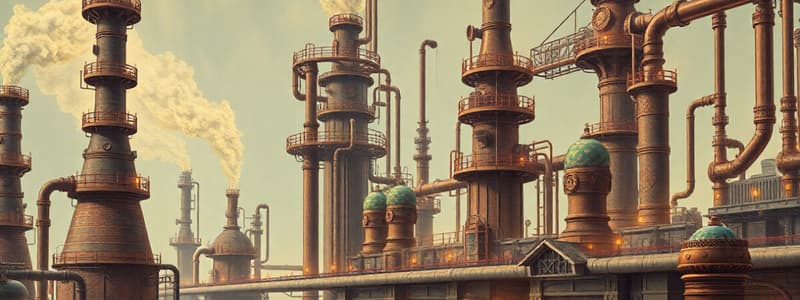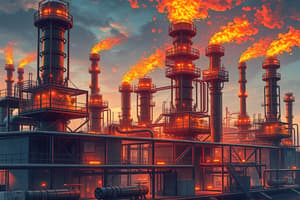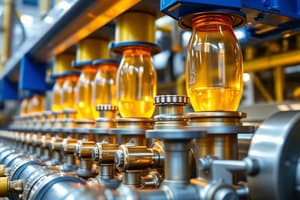Podcast
Questions and Answers
What is the primary product generated from thermal cracking?
What is the primary product generated from thermal cracking?
- Fullerenes
- Gaseous biogas
- Solid carbon
- Liquid bio-oil (correct)
How does increasing the temperature affect the yield of gas products during thermal cracking?
How does increasing the temperature affect the yield of gas products during thermal cracking?
- It decreases the yield of gas products.
- It has no effect on the yield.
- It increases the yield of gas products. (correct)
- It only affects the temperature of the reaction.
What role does the acidity of the catalyst play in catalytic cracking?
What role does the acidity of the catalyst play in catalytic cracking?
- It decreases the reaction rate.
- It enhances the reaction selectivity. (correct)
- It is irrelevant to the process.
- It promotes the formation of solid coke.
Which of the following is a mesoporous material that can be used as a catalyst in catalytic cracking?
Which of the following is a mesoporous material that can be used as a catalyst in catalytic cracking?
What is the main result of fast pyrolysis in thermal cracking?
What is the main result of fast pyrolysis in thermal cracking?
What is the purpose of controlled burning in a thermal cracking reactor?
What is the purpose of controlled burning in a thermal cracking reactor?
Which operational condition is defined by moderate temperatures and short residence times in thermal cracking?
Which operational condition is defined by moderate temperatures and short residence times in thermal cracking?
In catalytic cracking, what is the importance of the morphology of the catalyst?
In catalytic cracking, what is the importance of the morphology of the catalyst?
What is the primary goal of biomass fast pyrolysis?
What is the primary goal of biomass fast pyrolysis?
At what temperature is biomass fast pyrolysis typically performed?
At what temperature is biomass fast pyrolysis typically performed?
Which of the following processes is part of the thermal cracking of triglyceride molecules?
Which of the following processes is part of the thermal cracking of triglyceride molecules?
What role do zeolite catalysts play in the upgrading methods for bio-oil?
What role do zeolite catalysts play in the upgrading methods for bio-oil?
Which of the following processes is NOT associated with catalytic cracking?
Which of the following processes is NOT associated with catalytic cracking?
What is the expected product from the Diels-Alder addition of dienes to olefins during thermal cracking?
What is the expected product from the Diels-Alder addition of dienes to olefins during thermal cracking?
What is a significant consequence of the vapor residence time during biomass fast pyrolysis?
What is a significant consequence of the vapor residence time during biomass fast pyrolysis?
In the thermal cracking process, which reaction follows after the thermolysis of a triglyceride molecule?
In the thermal cracking process, which reaction follows after the thermolysis of a triglyceride molecule?
What is the primary outcome of the hydrotreating process in bio-oil upgrading?
What is the primary outcome of the hydrotreating process in bio-oil upgrading?
Which upgrading method involves the use of a catalyst at atmospheric pressure?
Which upgrading method involves the use of a catalyst at atmospheric pressure?
Which catalyst is primarily used in the catalytic cracking process described?
Which catalyst is primarily used in the catalytic cracking process described?
What is a significant characteristic of bio-oil that affects its transformation during upgrading?
What is a significant characteristic of bio-oil that affects its transformation during upgrading?
During hydrotreating, what is the typical operating pressure required?
During hydrotreating, what is the typical operating pressure required?
Which reaction is NOT a part of the catalytic cracking process?
Which reaction is NOT a part of the catalytic cracking process?
What type of products is primarily formed during the zeolite cracking process of bio-oil?
What type of products is primarily formed during the zeolite cracking process of bio-oil?
What is one of the pathways for oxygen removal in bio-oil upgrading?
What is one of the pathways for oxygen removal in bio-oil upgrading?
Flashcards are hidden until you start studying
Study Notes
Catalytic Cracking
- Two main characteristics determine catalytic cracking: acidity and morphology.
- Acidity is responsible for cracking activity.
- Mesoporous materials like MCM-41 and SBA-15 can be used as catalysts in cracking crude and used palm oil.
- Morphology determines selectivity via its pore accessibility.
Thermal Cracking
- Thermal cracking breaks larger hydrocarbons into smaller ones by heat alone.
- It occurs in the absence of oxygen and can be catalyzed.
- The process generates coke (solid), bio-oil (liquid), and biogas (gaseous).
- Temperature and residence time heavily influence product yield.
- Higher temperatures and longer residence times increase gas yield.
- Lower temperatures and longer residence times favor coke formation.
- Moderate temperatures and short residence times maximize liquid product yield, known as fast pyrolysis.
- Removing coke requires controlled burning in the reactor by feeding air instead of biomass.
Thermal Cracking Mechanism
- The process begins with the decomposition of the triglyceride molecule, forming heavy oxygenated hydrocarbons.
- It involves various sequential steps:
- Initial cracking (thermolysis of the triglyceride molecule ester bond)
- Decarboxylation/decarbonylation of long-chain oxygenated hydrocarbons
- C-C bond cleavage of unsaturated oxygenated hydrocarbons
- Decarboxylation/decarbonylation of short-chain oxygenated hydrocarbons
- Isomerization, polymerization/dehydrogenation, cyclization to form dienes, acetylenes, cycloparaffins, and polyolefins
- Dehydrogenations of cycloparaffins to form cyclo-olefins
- Hydrogenations of cyclo-olefins to form cycloparaffins
- Diels-Alder addition of dienes to olefins to form cyclo-olefins
- Aromatization of cyclo-olefins to form aromatics and polyaromatics hydrocarbons
- Coking from polyaromatics
- Coking by polycondensation of oxygenated hydrocarbons
- Coking by polycondensation of the triglyceride molecule
- Polymerization of olefins to form coke
- Direct route for C1-C5 hydrocarbon formation from the triglyceride molecule
Bio-oil Generation from Pyrolysis
- Pyrolysis is a thermochemical conversion process where biomass decomposes under high temperatures and no oxygen, producing condensable organic molecules, gases, and char.
- Fast pyrolysis aims to maximize bio-liquid yield.
- Key operating conditions for fast pyrolysis include temperature and vapor residence time.
- Fast pyrolysis is performed at approximately 500°C.
- Heat is transferred through convection, radiation, and conduction, breaking down biopolymers and releasing volatile components.
- The vapor residence time influences the composition of the bio-oil.
- Decarbonylation and decarboxylation reactions remove oxygen, forming CO and CO2.
- Double bonds and aromatics are saturated through hydrogenation.
- Hydrotreating involves high pressure and moderate temperatures, crucial for hydrogen solubility.
Upgrading Bio-oil
- Various upgrading methods exist:
- Non-catalytic fast hydropyrolysis
- Catalytic fast hydropyrolysis
- Non-catalytic fast hydropyrolysis with ex-situ hydrotreating
- Catalytic fast hydropyrolysis with ex-situ hydrotreating
Catalytic Cracking of Bio-oil
-
Oxygen removal in catalytic cracking occurs through reactions like cracking, decarboxylation, decarbonylation, dehydration, and water gas shift.
-
The process uses catalysts, primarily zeolites, under atmospheric pressure and temperatures between 300-600°C.
-
The overall chemical reaction can be represented as:
Bio-oil → CH<sub>1.2</sub> + CO<sub>2</sub> + CO + H<sub>2</sub>Owhere "CH1.2" represents an unspecified hydrocarbon product.
Zeolite Cracking of Bio-oil
- Bio-oil cracking over an acidic zeolite catalyst like H-ZSM-5 removes oxygen through cracking, forming CO and CO2.
- The resulting liquid product primarily consists of aromatics like benzene, toluene, xylenes, and naphthalene.
- The formation of aromatics is due to hydrogen deficiency in bio-oil.
- Compared to hydrotreating, catalytic cracking results in lower yields of liquid hydrocarbons because of carbon loss in the form of oxides.
- The process can be operated in either liquid or vapor phase.
Studying That Suits You
Use AI to generate personalized quizzes and flashcards to suit your learning preferences.




